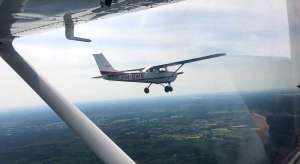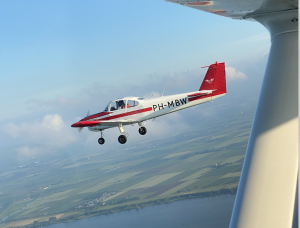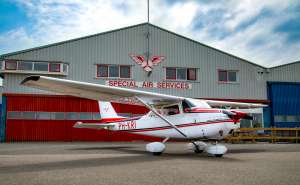Private Pilot License (PPL)
At Special Air Academy in Teuge we offer extensive Private Pilot License (PPL) training, which allows you to experience the freedom of flying. Our experienced instructors will guide you step by step, from theory to practice, so that you can take to the air safely and confidently.
The so-called Private Pilot License is the highest attainable entry-level license for a pilot. It is recognized worldwide and allows you to fly during the day in good weather. Unlike the Light Aircraft Pilot License (LAPL), your license can be used all over the world and you can immediately take passengers on board after obtaining your license. It is also possible to expand your certificate with different annotations. This makes it possible, for example, to fly in the dark while using only your instruments or even to fly upside down!
Whether you fly on the cozy Cessna 150, the famous Cessna 172 or the breathtaking Fuji, the route to get there is the same. The PPL training program is divided into four phases. Each phase ends with a progression test.
Phase one

Cessna 150
Here you will learn the basics of flying, such as learning how to land and take off an airplane. During this phase you work towards solo flight. Before you can leave your instructor behind and carry out landings yourself, it is necessary that you are at least in possession of a class 2 medical certificate. We recommend that you obtain your medical certificate as early as possible during your training. This prevents any delays during your training. After you have passed the first progress test, it is time for the long-awaited first solo, after which you move on to the second phase. Don’t forget to bring dry clothes to your first solo, as it is tradition to end this unique flight with a cold shower where your instructor will be ready with a bucket of water.
Phase two

Fuji
Phase two focuses on advanced maneuvers and navigating the air. What to do if the engine does not work properly or if the weather deteriorates? After these lessons you will know what to do in these types of situations. During this phase you will also fly with our acrobatic (“stunt”) aircraft. The purpose of this is to learn the limits of the aircraft and how to get the aircraft out of tight situations. You might even fly upside down or do a loop! Flying to another airport for lunch is one of the many reasons to fly, during this phase we are going to teach you how to navigate to these restaurants using only a map, compass, clock and the view from the cockpit. After you have completed this phase you will be able to fly to other airports during your solo flights. To make this easier, we also teach you radiotelephony during this phase. There are two ways to learn radiotelephony: attending classroom sessions with your fellow students or one-on-one instruction with an instructor. The choice is yours. After completing the radiotelephony course, we plan an English language test.
phase three

Cessna 172
Here you will learn more advanced navigation techniques, including navigation using radio beacons and navigating in poor visibility. You will also visit a larger airport with air traffic control such as Groningen Eelde airport and visit a foreign airport. At the end of this phase you will fly a flight of 150 nautical miles (280 km) to two airports. For example from Teuge to Texel, Texel to Hoogeveen and then back to Teuge.
phase four
Phase four is the final phase before you obtain your certification. In the meantime, you have achieved all the milestones required before you can take the final practical exam: the skills test. During these last lessons you will put the finishing touches to your flying skills by flying the same routine as in the skill test or by practicing extra with that one difficult exercise. When you and the instructor both feel that you are ready, we will make an appointment with the examiner for the skill test.
What does a lesson look like?
Each lesson starts with a briefing about the exercises that will take place. After this, you go to the aircraft and start the pre-flight inspection, and if necessary, you also refuel the aircraft. If all is well, you taxi to the runway and carry out the necessary checks and complete the checklist, after which you take off. After landing, park the aircraft and perform final inspections of the aircraft. After this you go to the classroom and follow the debriefing. During this debriefing you will discuss the exercises performed and the preparation for the next lesson.
If you cannot fly due to bad weather, this time will be used to review theory (aircraft-specific information). Additionally, it is possible to prepare for future flights or use the simulator to practice the basics of instrument flying. The time you spend in the simulator does not count towards the hours needed to obtain your license, but it will help you if you accidentally fly into a cloud.
The theory
In addition to learning to fly, it is also important that you learn how and why an airplane flies, how the weather affects flight performance and what you are and are not allowed to do. To learn this you must take the following subjects during your theory training. The theory for the LAPL and PPL can be followed by several trainers. In addition to the SAS itself offering a theory course, we have selected two theory schools for students of Special Air Academy. All providers offer the same subjects with the same standard. The theory exams can be taken at the CBR or at Austrocontrol (exams take place in Arnhem).
We recommend that you first complete the communications course before starting the radiotelephony course in phase two. Furthermore, we also recommend that you start working on theory early during the practical part of the training. This will help you understand why certain procedures exist and how they apply. The theory part is not difficult, but it is simply a lot of material to cover.
Keep the certificate
When you receive your certificate, you will also receive a note next to it. In your case this will be a single engine piston (SEP). This means that you can fly on any single-engine aircraft with a piston engine. Some aircraft require additional training with an instructor, such as when moving to an aircraft with retractable landing gear. The license itself is therefore valid for your entire life, but does not grant any flying privileges.
In short, the license determines what type of operation you can fly (private or commercial) and the endorsements determine the types of aircraft you can fly. The SEP endorsement is valid for 2 years, to renew this endorsement you must have flown 12 hours in the past 12 months (including 1 hour with an instructor). If you do not meet this requirement, you must do a proficiency check with an examiner. This check is comparable to the skills test you have already taken at the end of your practical training. If you have not renewed your endorsement and it has now expired, you must take flying lessons again at a flying school and then pass the proficiency check.
The PPL(A) training may only be given by a government-registered and recognized flying school, such as Special Air Academy. The minimum age for applying for the license (license) is 17 years.
Download the price list for the PPL training here
In a nutshell
Practical training hours requirements
For a PPL(A) license, the student pilot must have flown at least 45 training hours with and under the supervision of an instructor. These 45 flight hours consist of:
- Minimum of 25 hours with a flight instructor
- at least 10 hours solo
- minimum 5 hours of solo overland (min. 150 NM and two full-stop landings at two airports)
The theory exam
The theory exam consists of the following subjects:
- Air Law & ATC procedures
- Aircraft general knowledge
- Principles of Flight and Flight performance and planning
- Navigation
- Meteorology
- Human performance
- Communications
All theory subjects must be passed within 18 months. After passing the PPL(A) theory exam, you can take the practical exam. The practical exam must be passed within 24 months after the theory exam.
Radiotelephony
Furthermore, a radiotelephony course must be successfully completed. For more information about the RT training, click here.
LPE-test
LPE stands for Language Proficiency Endorsement. LPE is a test that takes about an hour to complete. The aspiring pilot must undergo this test to determine whether the level of (aviation) English is up to standard. With the result, the pilot receives a ‘mark’ on a scale of 1 to 6. If the pilot gets a 4 or higher, he has passed. If you would like more information about the LPE, please do not hesitate to contact us.
We would like to invite you to take a trial flying lesson with our company without obligation.
